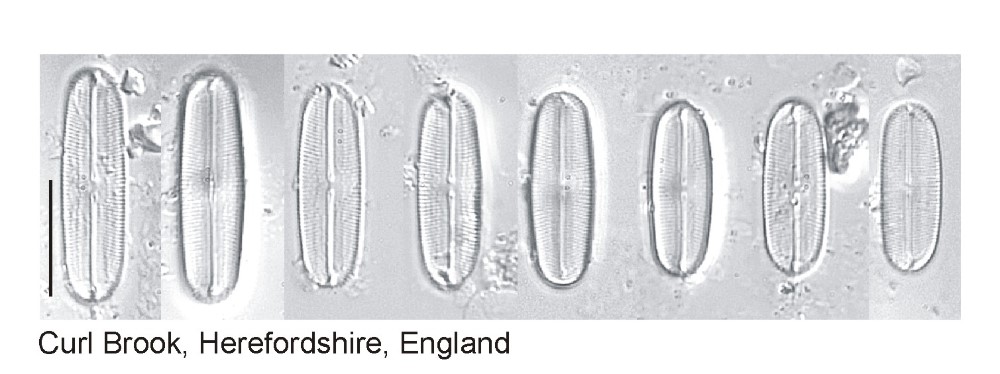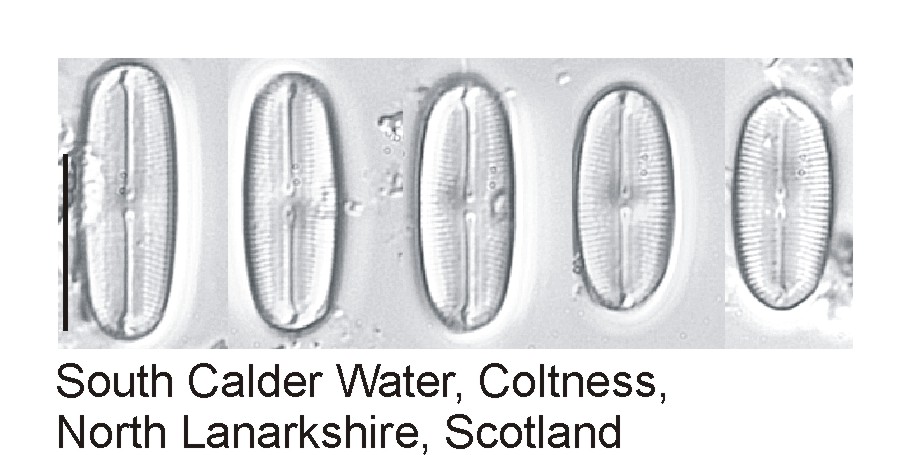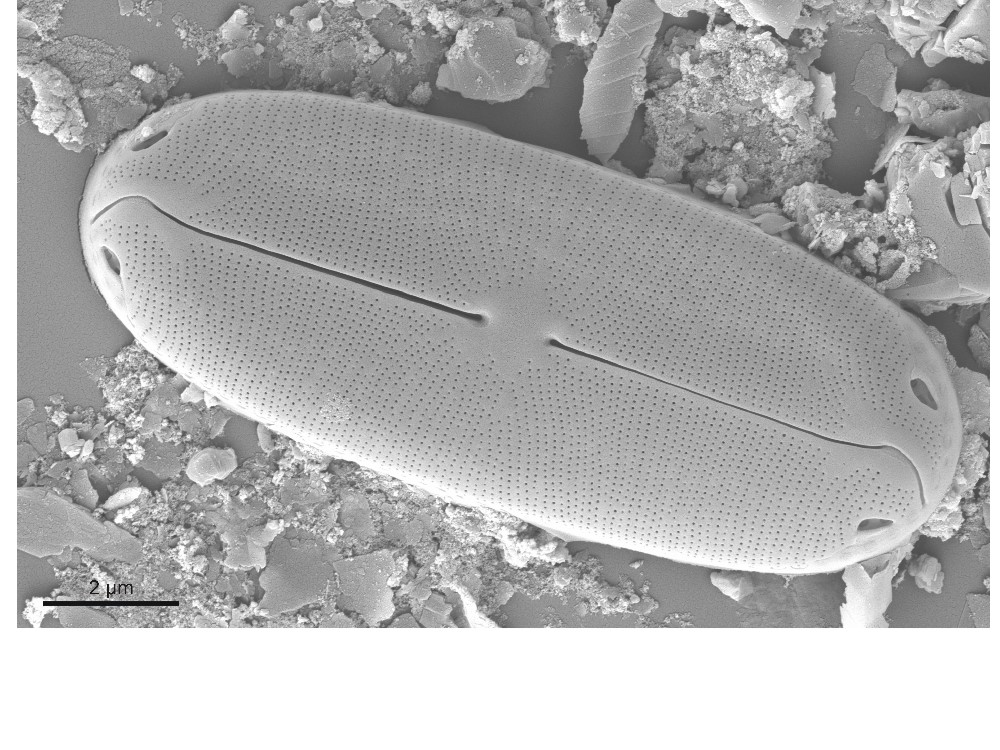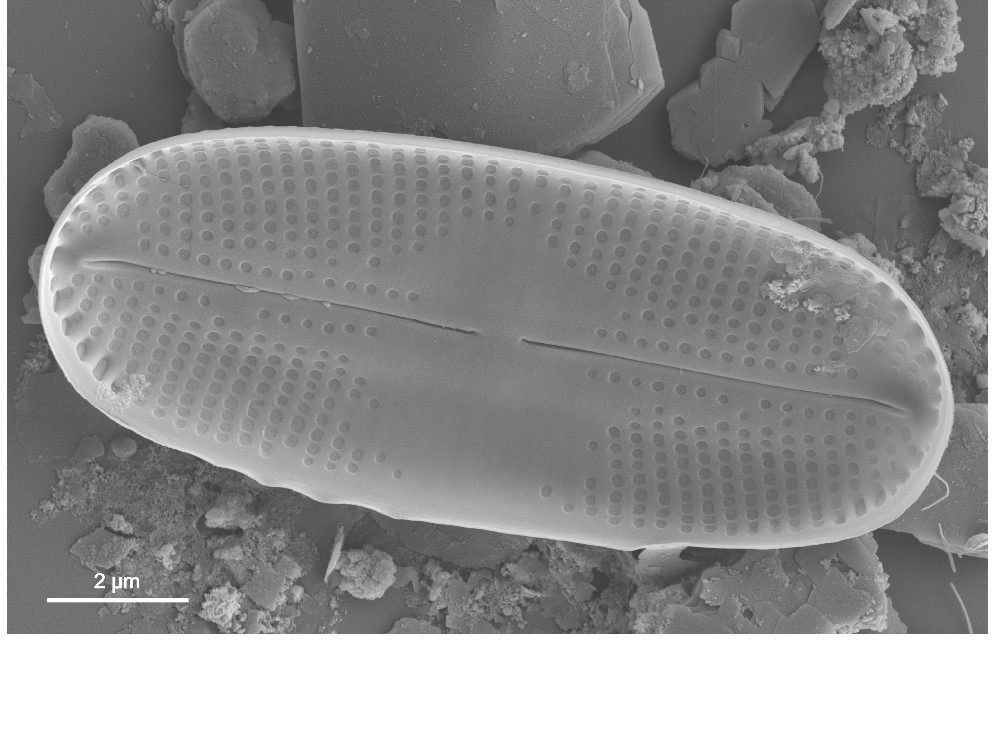Fallacia subhamulata (Grunow in Van Heurck) Mann in Round, Crawford & Mann; 1990; 669
Synonymy
Navicula subhamulata Grunow in Van Heurck 1880
Fallacia subhamulata Bukhtiyarova 1995
Key references
Hofmann G., Werum M., Lange-Bertalot H. 2011. Diatomeen im Süßwasser-Benthos von Mitteleuropa. A.R.G. Gantner, Ruggell. 908 pp
Morphology
Shape
Linear-elliptic with broadly rounded ends.
Symmetry
Isopolar, bilaterally symmetrical.
Striae
In LM striae appear radiate throughout (though not strongly) and contain widely spaced areolae. The electron microscope, (e.g. Krammer & Lange-Bertalot 1986, pl. 83, fig. 4) reveals that the striae are completely covered externally by a conopeum, which is perforated by a multitude of tiny pores arranged close together in rows that are radiate in the valve centre, are parallel outside the central section of the valve, and become convergent near the ends. The conopeum is supported along the centre of the valve by the narrow longitudinal ribs adjacent to the raphe.
Axial area
The true axial area (i.e. the plain area next to the raphe) is usually narrow. Much more obvious is a wide zone (occupying approximately one-third of the width of the valve) in which the striae appear much fainter than near the margin. In this part of the valve, the transapical ribs (virgae) are depressed and thinner. The two raphe slits appear to be enclosed in narrow longitudinal ribs, which are clearly separated from each other at the centre.
Central area
The extent of the central area is difficult or impossible to establish in LM because of the faintness of the striae in the middle third of the valve width. Sometimes there appears to be a large rounded, sometimes asymmetrical central area, elsewhere no area can be distinguished. However, the rows of conopeum pores are interrupted by a large oval plain area.
Raphe
Straight with slightly expanded central ends, and distal fissures deflected to the secondary side of the valve, terminating on the mantle (SEM).
Other features
The polar raphe endings are more distant from the valve ends than in most naviculoid diatoms, so that it is particularly easy to see the deflection of the terminal fissures.
SEM morphology
The external face of the valve is almost wholly covered by a finely porous conopeum; thereby canals are formed within the thickness of the cell wall, between the conopeum and the transapical ribs (virgae) and striae below.
However, large window-like openings are present on the valve surface on both sides of the distal raphe fissures at the poles where the conopeum has not merged with a fold at the valve face/mantle junction. Here, the canals beneath the conopea open to the exterior.
Hyaline areas are present in the conopeum around the distal ends of the valve.
Linear-elliptic with broadly rounded ends.
Symmetry
Isopolar, bilaterally symmetrical.
Striae
In LM striae appear radiate throughout (though not strongly) and contain widely spaced areolae. The electron microscope, (e.g. Krammer & Lange-Bertalot 1986, pl. 83, fig. 4) reveals that the striae are completely covered externally by a conopeum, which is perforated by a multitude of tiny pores arranged close together in rows that are radiate in the valve centre, are parallel outside the central section of the valve, and become convergent near the ends. The conopeum is supported along the centre of the valve by the narrow longitudinal ribs adjacent to the raphe.
Axial area
The true axial area (i.e. the plain area next to the raphe) is usually narrow. Much more obvious is a wide zone (occupying approximately one-third of the width of the valve) in which the striae appear much fainter than near the margin. In this part of the valve, the transapical ribs (virgae) are depressed and thinner. The two raphe slits appear to be enclosed in narrow longitudinal ribs, which are clearly separated from each other at the centre.
Central area
The extent of the central area is difficult or impossible to establish in LM because of the faintness of the striae in the middle third of the valve width. Sometimes there appears to be a large rounded, sometimes asymmetrical central area, elsewhere no area can be distinguished. However, the rows of conopeum pores are interrupted by a large oval plain area.
Raphe
Straight with slightly expanded central ends, and distal fissures deflected to the secondary side of the valve, terminating on the mantle (SEM).
Other features
The polar raphe endings are more distant from the valve ends than in most naviculoid diatoms, so that it is particularly easy to see the deflection of the terminal fissures.
SEM morphology
The external face of the valve is almost wholly covered by a finely porous conopeum; thereby canals are formed within the thickness of the cell wall, between the conopeum and the transapical ribs (virgae) and striae below.
However, large window-like openings are present on the valve surface on both sides of the distal raphe fissures at the poles where the conopeum has not merged with a fold at the valve face/mantle junction. Here, the canals beneath the conopea open to the exterior.
Hyaline areas are present in the conopeum around the distal ends of the valve.
Literature
References are given in chronological order.
Reference |
Citation |
|---|---|
| Van Heurck H. 1880. Synopsis des Diatomées de Belgique. Atlas. Ducaju & Cie., Anvers.; 1-30 pls | Morphology; Description; Illustrations |
| Round F.E., Crawford R.M., Mann D.G. 1990. The Diatoms. Biology & Morphology of the Genera. Cambridge University Press, Cambridge. 747 pp | Taxonomy |
| Hofmann G., Werum M., Lange-Bertalot H. 2011. Diatomeen im Süßwasser-Benthos von Mitteleuropa. A.R.G. Gantner, Ruggell. 908 pp | Morphology; Ecology; Illustrations |
This page should be cited as:
Mann D. G., Jüttner I. Fallacia subhamulata (Grunow in Van Heurck) Mann in Round, Crawford & Mann; 1990; 669. In: Jüttner I., Carter C., Cox E.J., Ector L., Jones V., Kelly M.G., Kennedy B., Mann D.G., Turner J. A., Van de Vijver B., Wetzel C.E., Williams D.M..
Freshwater Diatom Flora of Britain and Ireland. Amgueddfa Cymru - National Museum Wales. Available online at https://naturalhistory.museumwales.ac.uk/diatoms/browsespecies.php?-recid=4515. [Accessed:
].
Record last modified: 27/12/2020





